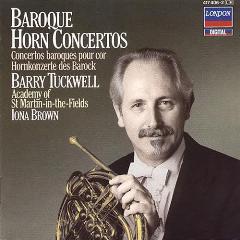Baroque Horn Concertos (Tuckwell) [1990]
Baroque Horn Concertos (Tuckwell) [1990]

Knechtl - 01] Concerto in D major-I Allegro Knechtl - 02] Concerto in D major-II Adagio Knechtl - 03] Concerto in D major-III Allegro Reinhardt - 04] Concerto in E flat major-I Moderato Reinhardt - 05] Concerto in E flat major-II Siciliano Reinhardt - 06] Concerto in E flat major-III Allegro ma non presto Quantz - 07] Concerto No.3 in E flat major-I Allegro Quantz - 08] Concerto No.3 in E flat major-II Adagio cantabile Quantz - 09] Concerto No.3 in E flat major-III Allegro Quantz - 10] Concerto No.9 in E flat major-I Allegro Quantz - 11] Concerto No.9 in E flat major-II Siciliano-Larghetto Quantz - 12] Concerto No.9 in E flat major-III Allegro Graun - 13] Concerto in D major-I Moderato Graun - 14] Concerto in D major-II Adagio Graun - 15] Concerto in D major-III Allegro Röllig - 16] Concerto No.14 in E flat major-I Moderato Röllig - 17] Concerto No.14 in E flat major-II Siciliano Röllig - 18] Concerto No.14 in E flat major-III Tempo di menuetto Röllig - 19] Concerto No.15 in D major-I Allegro ma non molto Röllig - 20] Concerto No.15 in D major-II Siciliano Röllig - 21] Concerto No.15 in D major-III Allegro: Tempo di menuetto Barry Tuckwell - French Horn Academy of St. Martin in the Fields Iona Brown – conductor
Seven baroque concertos in a row, played with exuberant virtuosity by a master hornist brings over an hour of music, none of it great music, but pleasingly inventive and creating electricity from the bravura demanded of the soloist—met here with confident aplomb by Barry Tuckwell. The high tessitura of the bouncing first movement of the Knechtl has a counterpart in the opening movements of the two concertos Rollig concertos, their basic atmosphere more relaxed and galant but still demanding the most nimble articulation and controlled trills. Reinhardt's decorative writing is so florid that one feels at times there are almost too many notes, and the soloist is also tested by wide leaps in the melodic line, even in the siciliano slow movement. The siciliano format is also favoured by Quantz and Rollig (in both his concertos). I thought Quantz's No. 9 all-in-all the most engaging work here, featuring as it does a concertante oboe soloist, whose melodic line often graciously echoes that of the horn. But the Graun is a good piece also, quite short (the Adagio only lasts 1'53'' but is still memorable) and the outer movements are strong in character, particularly the finale with its snapping grace notes.
Throughout Iona Brown provides polished, stylish accompaniments: the sound made by the ASMF strings is clean and bright in allegros, seemingly reflecting the influence of the 'authentic' movement, although modern instruments are used by everyone (including the soloist) to excellent musical effect. The sound is fresh and transparent, the harpsichord continuo coming through realistically without a false balance. -- Ivan March, Gramophone [7/1987], arkivmusic.com
download: uploaded anonfiles mega 4shared mixturecloud yandex mediafire ziddu








